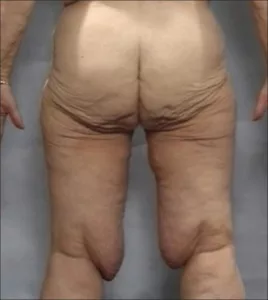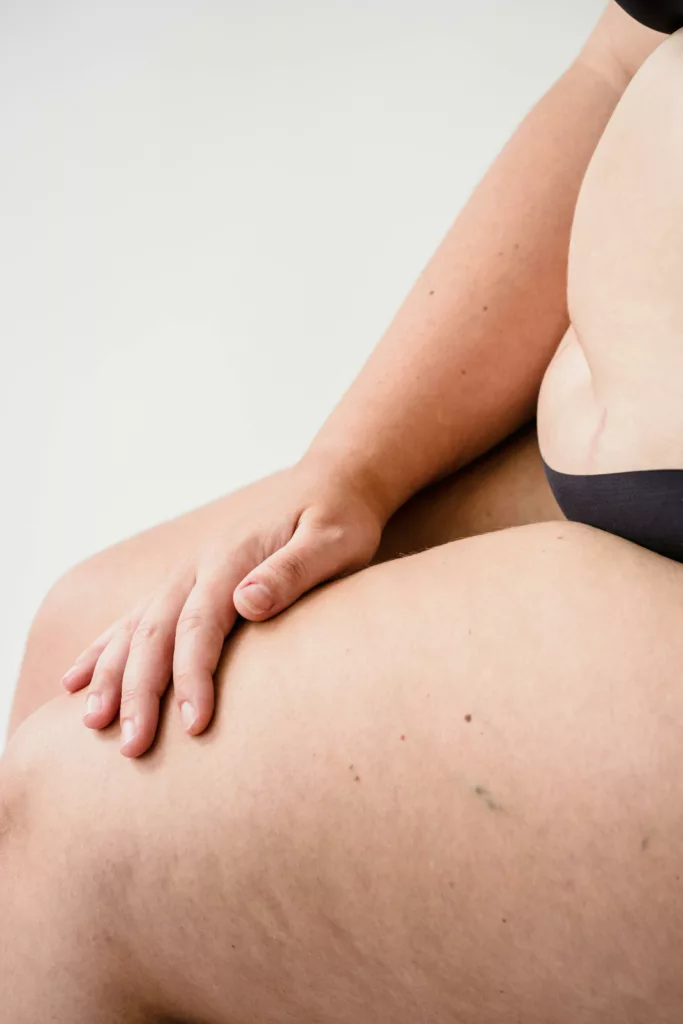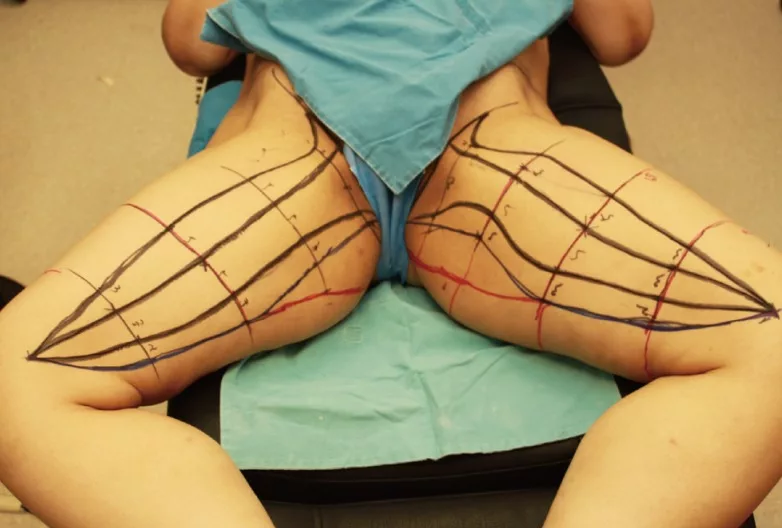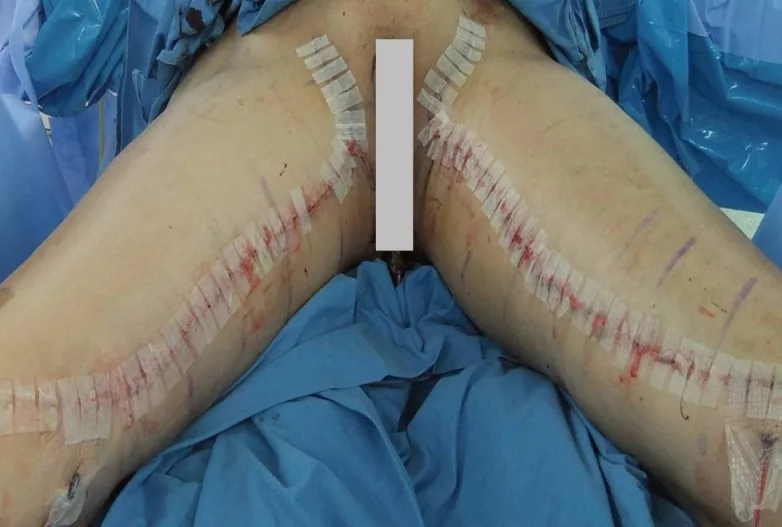Thighplasty, commonly known as a thigh lift, is a cosmetic surgical procedure designed to remove excess skin and fat from the thighs. The primary goal of this surgery is to enhance the contour, tone, and overall appearance of the thighs. It is particularly popular among individuals who have experienced significant weight loss, leading to sagging or loose skin that cannot be addressed through exercise or non-surgical means.
According to the American Society of Plastic Surgeons, cosmetic surgeons yearly perform more than 9000 thighplasty procedures.1American Society of Plastic Surgeons. (2020). 2020 Plastic Surgery Statistics Report. Retrieved from https://www.plasticsurgery.org/documents/News/Statistics/2020/plastic-surgery-statistics-full-report-2020.pdf

Thighplasty Vs. Liposuction
It is noteworthy that thigh lift surgery primarily focuses on removing excess sagging skin and minor amounts of fat from the thighs. It is not designed as a weight-loss procedure but rather as a contouring solution for improving the appearance of the thighs, especially after significant weight loss or due to age-related skin laxity.
In contrast, liposuction specifically targets the removal of fat deposits and is suitable for individuals looking to reduce fat in the thigh area or other parts of the body. Liposuction does not address loose or sagging skin, which makes it less ideal for patients with significant skin laxity.
In some cases, surgeons may combine thighplasty with liposuction to achieve optimal results, addressing both excess fat and loose skin based on the patient’s unique needs.
Types Of Thighplasty
Surgeons across the globe perform different types of thigh lift surgeries:
Minimal Thighplasty (Mini thigh lift):
The surgeon decides which type of thighplasty is better suited for the patient. Patients requiring minimal changes in the thigh skin may undergo a mini thigh lift. In this particular procedure, the surgeon removes skin via very small incisions. In most cases, the surgeon gives a crescent-shaped incision on the thigh that follows along the crease of the inner groin and ends near the fold of the buttocks. It focuses mainly on the upper-inner part of the thigh skin.
Medial Thighplasty:
Also known as inner thigh lift, this is the most common thigh lift surgery. This procedure helps tighten the inner part of the thigh. The surgeon begins with an incision in your groins, extends it to the back of the thigh, and ends at a point below the buttocks. It significantly improves the quality of life in patients suffering from massive weight loss sequelae.2Mocquard, C., Pluvy, I., Chaput, B., Hoogbergen, M. M., Watier, E., Gandolfi, S., & Bertheuil, N. (2021). Medial thighplasty improves patient’s quality of life after massive weight loss: A prospective multicentric study. Obesity Surgery, 31, 4985-4992.
Moreover, medial thighplasty is a safe procedure associated with minimum postoperative complications. The evident aesthetic improvements lead to better patient satisfaction.3Di Pietro, V., Gianfranco, M. C., Cervelli, V., & Gentile, P. (2019). Medial thigh contouring in massive weight loss: a liposuction-assisted medial thigh lift. World journal of plastic surgery, 8(2), 171.
Medial thighplasty is further divided into types based on the type of incision:
Horizontal Medial Thighplasty
Horizontal incision on the medial thigh skin has good postoperative results. Experts choose horizontal incision in patients with less to moderate skin excess. Patients with excess skin in the proximal part of the medial thigh and firmer skin in the distal region are ideal candidates for the sole horizontal thigh lift technique (H-shaped incision).4Kühn, S., Klettenheimer, A., Küenzlen, L., Kiehlmann, M., Schlosshauer, T., Djedovic, G., & Rieger, U. M. (2019). Outcome, complications, and body mass index correlation of horizontal and combined horizontal and vertical thigh lift: A 16-year single-center experience. Journal of cutaneous and aesthetic surgery, 12(4), 231-236. The medial horizontal approach has less scarring, fewer complications, and improved aesthetics. Therefore, a higher rate of patient satisfaction is observed.5Schwaiger, K., Russe, E., Heinrich, K., Ensat, F., Steiner, G., Wechselberger, G., & Hladik, M. (2018). Thighplasty: improving aesthetics through the revival of the medial, horizontal procedure: A safe and scar-saving option. Journal of Plastic, Reconstructive & Aesthetic Surgery, 71(4), 585-589.
Vertical Medial Thighplasty
In some cases, the surgeon may opt for a vertical incision for skin removal. Modern surgeons may combine horizontal and vertical incisions to enhance skin healing and minimize scarring. The increase in the number of bariatric surgeries (obesity surgery) has raised the number of vertical medial thighplasties. A j-shaped vertical medial thigh lift is associated with some morbidities that can be managed.6Bertheuil, N., Duisit, J., Bekara, F., Watier, E., Gandolfi, S., & Bergeat, D. (2021). Risk Factors for Complications after J Medial Thighplasty following Massive Weight Loss: A Multivariate Analysis of 94 Consecutive Patients. Plastic and reconstructive surgery, 148(4), 540e-547e.
Based on the shape of the incision, medial thighplasty is divided into the following techniques:
- Crescent-shaped technique
- T-shaped technique
- L-shaped technique
- Concentric medial lift technique
- Double triangle technique
Bilateral Thighplasty:
Also commonly known as outer thigh lift, it targets the skin on the outer portion of the thigh (outside and front of the thigh). The surgeon begins incising at the upper groin area and extends to the lower back (waist) region. Unlike mini and medial thighplasty, bilateral thighplasty may require an overnight hospital stay.
Spiral Thighplasty:
This technique targets a larger area of the thighs. With spiral thigh lifts, surgeons can remove the skin from the inner, outer, front, and back regions of the thigh. Spiral thighplasty has better outcomes as the scar lines are well hidden in the natural creases. Studies report achieving full body lift and reducing circumferential thigh laxity with a spiral thigh lift.7Woldanski, L., & Russell, R. (2023, April). The Spiral Lift: A Novel Twist on Body Contouring. In Aesthetic Surgery Journal Open Forum (Vol. 5, No. Supplement_1, pp. ojad027-019). US: Oxford University Press.
Thighplasty With Liposuction (Bariatric Surgery):
In cases with poor skin elasticity, the surgeon advises liposuction along with thighplasty. This allows the removal of excess fat cells and prevents the sagging of skin. Surgeons can achieve good results and high patient satisfaction with proper patient selection. However, simultaneous liposuction and thighplasty require meticulous and cautious handling of the tissues.8Aboueldahab, A. K. (2013). Liposuction-assisted medial thigh lifts in obese and nonobese patients. Journal of cutaneous and aesthetic surgery, 6(4), 217-225. If your surgeon allows, you may also choose other cosmetic procedures (simultaneously with thigh lift) such as butt lift, etc.

What To Do Before A Thighplasty?
If you are about to undergo a thighplasty procedure, we suggest you take proper pre-op instructions from your doctor. During the consultation, your surgeon will analyze your skin and understand your motives for the surgery. He then informs you about the expected outcomes and the possible adverse effects that you may suffer from. Healthcare providers advise taking certain medications and stopping some. As a general rule, you may be asked to do the following:
- Stop smoking, as it can lead to post-operative complications.
- Discontinue medications like aspirin, clopidogrel (blood-thinners), ibuprofen and herbal supplements, etc.
- Stay hydrated to avoid anesthesia-induced post-operative constipation.
- Do not eat/drink 8 hours prior to surgery, i.e., follow the NPO (nothing per mouth) protocol.
Thighplasty Procedure Details
The entire procedure takes around a couple of hours to complete. Before beginning the surgery, your surgeon marks incision lines on the skin. The lines may be at different angles (depending on the surgeon’s will and plan). This is done while the patient is standing.
In the next step, an anesthesiologist administers general anesthesia so that you don’t feel any pain or discomfort during the procedure.

Then, your surgeon makes the incision, starting from the groin. The shape and extent of the incision varies from patient to patient. The next step is the removal of skin and excessive fat cells. This is followed by the repositioning of the tissues and the neighboring muscles/skin cells. After all the excess skin is removed and the remaining skin is repositioned, your surgeon will close the wounds, i.e., stitch up the incisions.
Thighplasty Recovery
How Long Does It Take To Recover From The Procedure?
In mini and medial thigh lifts, patients are discharged on the same day. However, you may need to stay at the hospital for one day when undergoing a bilateral thigh lift. It generally requires an overnight stay.

The incision site generally heals completely within six weeks. However, you might notice swelling for a longer period. It may take up to six months for the complete clearance of swelling. This duration may increase for patients with comorbidities like diabetes, etc.
How Soon Can You See Results?
You can observe the full extent of your correction months after the surgery. As swelling takes several months to resorb completely, you will notice the improved contour after almost six months.
How To Care For The Wounds After Surgery?
Post-operative care is important for uneventful healing. As a part of the routine practice, your surgeon might place tubes and dressings to remove body fluids and ease swelling. You will need to revisit the surgeon for the removal of these items.
Like any surgical procedure, you are expected to see some bruising and swelling accompanied by pain. The mild surgical complications go away gradually. However, you can speed up the process by adopting some simple steps.
- Take anti-inflammatory pain medications (prescribed by your doctor).
- You can wear compression garments to reduce swelling quickly. Careful assessment and use of post-operative compression garments can benefit aesthetic surgery patients.9Ormseth, B. H., Livermore, N. R., Schoenbrunner, A. R., & Janis, J. E. (2023). The Use of Postoperative Compression Garments in Plastic Surgery—Necessary or Not? A Practical Review. Plastic and Reconstructive Surgery–Global Open, 11(9), e5293.
- Avoid using a bathtub or swimming in a pool until your surgeon allows it.
- The doctor may ask you to abstain from showering for 48 hours after the procedure.
- It is better to take ample rest to allow fast healing. While you may resume work after 10 days, it is safe to avoid physical activity till 6 weeks.
Are There Any Risks Involved With Thighplasty?
Yes, there are certain risks involved in thighplasty. Some of them are related to poor outcomes, while others are serious surgical complications. Potential thighplasty risks include:
- Unattractive scaring
- Loose skin
- Asymmetrical positioning of the skin
- Loss of skin elasticity
- Permanent skin discoloration
- Poor wound healing (bleeding, pain, wound dehiscence, etc.)
- Wound infection
- Numbness
- Lymphatic fluid buildup (Seroma)
- Deep venous thrombosis (DVT)
- Heart and lung complications
- Necrosis of fat and skin
Mild complications after cosmetic surgeries are common, which resolve soon. However, you must report to the ER if you experience any of these symptoms:
- Fever/chills
- Excessive bleeding
- Pain unresponsive to pain-killers
- Delayed healing (if wounds do not show any significant healing during the first few weeks)
- Significant leg swelling
Final Word
Thighplasty is a surgical cosmetic procedure done to enhance the contour of the thighs in patients who have lost a significant amount of weight. It improves the contour and tone of the thighs. Doctors may combine thighplasty with liposuction and butt lift, etc. You can undergo different types of thighplasty surgeries, i.e., mini, medial, bilateral, and spiral. Medial thighplasty is the most common type, while spiral removes the greatest amount of skin. Serious complications are rare, and the wounds heal within 6 weeks. However, you can see results after the swelling subsides, i.e., after 6 months.
Refrences
- 1American Society of Plastic Surgeons. (2020). 2020 Plastic Surgery Statistics Report. Retrieved from https://www.plasticsurgery.org/documents/News/Statistics/2020/plastic-surgery-statistics-full-report-2020.pdf
- 2Mocquard, C., Pluvy, I., Chaput, B., Hoogbergen, M. M., Watier, E., Gandolfi, S., & Bertheuil, N. (2021). Medial thighplasty improves patient’s quality of life after massive weight loss: A prospective multicentric study. Obesity Surgery, 31, 4985-4992.
- 3Di Pietro, V., Gianfranco, M. C., Cervelli, V., & Gentile, P. (2019). Medial thigh contouring in massive weight loss: a liposuction-assisted medial thigh lift. World journal of plastic surgery, 8(2), 171.
- 4Kühn, S., Klettenheimer, A., Küenzlen, L., Kiehlmann, M., Schlosshauer, T., Djedovic, G., & Rieger, U. M. (2019). Outcome, complications, and body mass index correlation of horizontal and combined horizontal and vertical thigh lift: A 16-year single-center experience. Journal of cutaneous and aesthetic surgery, 12(4), 231-236.
- 5Schwaiger, K., Russe, E., Heinrich, K., Ensat, F., Steiner, G., Wechselberger, G., & Hladik, M. (2018). Thighplasty: improving aesthetics through the revival of the medial, horizontal procedure: A safe and scar-saving option. Journal of Plastic, Reconstructive & Aesthetic Surgery, 71(4), 585-589.
- 6Bertheuil, N., Duisit, J., Bekara, F., Watier, E., Gandolfi, S., & Bergeat, D. (2021). Risk Factors for Complications after J Medial Thighplasty following Massive Weight Loss: A Multivariate Analysis of 94 Consecutive Patients. Plastic and reconstructive surgery, 148(4), 540e-547e.
- 7Woldanski, L., & Russell, R. (2023, April). The Spiral Lift: A Novel Twist on Body Contouring. In Aesthetic Surgery Journal Open Forum (Vol. 5, No. Supplement_1, pp. ojad027-019). US: Oxford University Press.
- 8Aboueldahab, A. K. (2013). Liposuction-assisted medial thigh lifts in obese and nonobese patients. Journal of cutaneous and aesthetic surgery, 6(4), 217-225.
- 9Ormseth, B. H., Livermore, N. R., Schoenbrunner, A. R., & Janis, J. E. (2023). The Use of Postoperative Compression Garments in Plastic Surgery—Necessary or Not? A Practical Review. Plastic and Reconstructive Surgery–Global Open, 11(9), e5293.

